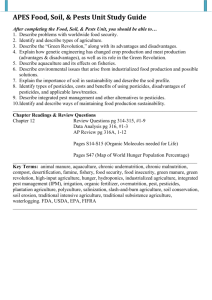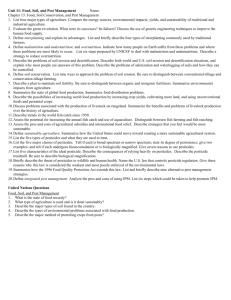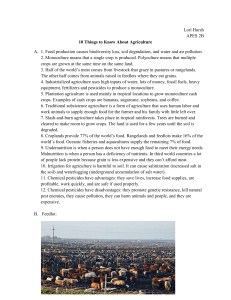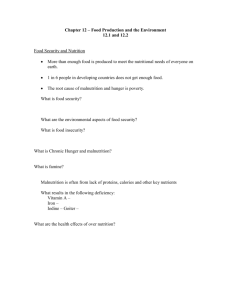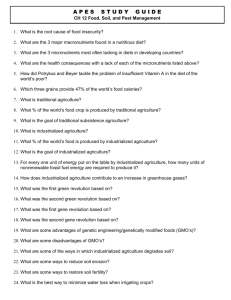Ch 3 and 13 Soils Part 2 - School District of La Crosse
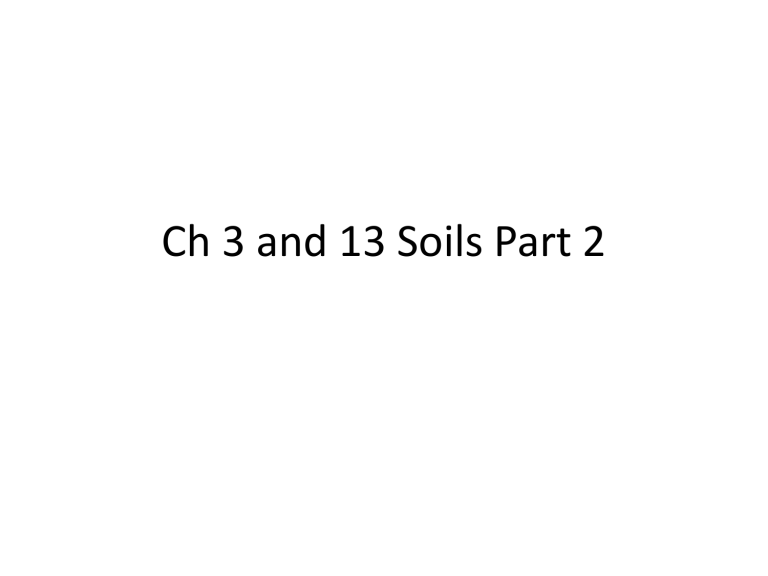
Ch 3 and 13 Soils Part 2
Global Outlook: Soil Erosion
• Soil is eroding faster than it is forming on more than one-third of the world ’ s cropland.
Figure 13-10
Case Study: Soil Erosion in the U.S. –
Some Hopeful Signs
• Soil erodes faster than it forms on most U.S. cropland, but since 1985, has been cut by about
40%.
– 1985 Food Security Act (Farm Act): farmers receive a subsidy for taking highly erodible land out of production and replanting it with soil saving plants for
10-15 years.
SUSTAINABLE AGRICULTURE
THROUGH SOIL CONSERVATION
• Terracing, contour planting, strip cropping, alley cropping, and windbreaks can reduce soil erosion.
Figure 13-16
SUSTAINABLE AGRICULTURE
THROUGH SOIL CONSERVATION
• Modern farm machinery can plant crops without disturbing soil (no-till and minimum tillage.
– Conservation-tillage farming:
• Increases crop yield.
• Raises soil carbon content.
• Lowers water use.
• Lowers pesticides.
• Uses less tractor fuel.
SUSTAINABLE AGRICULTURE
THROUGH SOIL CONSERVATION
• Fertilizers can help restore soil nutrients, but runoff of inorganic fertilizers can cause water pollution.
– Organic fertilizers : from plant and animal (fresh, manure, or compost) materials.
– Commercial inorganic fertilizers : Active ingredients contain nitrogen, phosphorous, and potassium and other trace nutrients.
THE GREEN REVOLUTION AND ITS
ENVIRONMENTAL IMPACT
• Since 1950, high-input ag. has produced more crops per unit of land.
• Three parts to “Green Revolution”
– Develop and plant monocultures
– Use pesticides, fertilizer and water
– Multiple cropping
– Second “Green” Revolution—fast growing, dwarf varieties that produce more food on less land.
THE GREEN REVOLUTION AND ITS
ENVIRONMENTAL IMPACT
• Modern agriculture has a greater harmful environmental impact than any human activity.
• Loss of a variety of genetically different crop and livestock strains might limit raw material needed for future green and gene revolutions.
– In the U.S., 97% of the food plant varieties available in the 1940 no longer exist in large quantities.
THE GENE REVOLUTION
• The winged bean, a
GMF, could be grown to help reduce malnutrition and the use of large amounts of inorganic fertilizers.
Figure 13-20
Animation: Transferring Genes into Plants
PLAY
ANIMATION
Mixing Genes
• Genetic engineering involves splicing a gene from one species and transplanting the
DNA into another species.
Figure 13-19
How Would You Vote?
To conduct an instant in-class survey using a classroom response system, access “ JoinIn Clicker Content ” from the PowerLecture main menu for
Living in the Environment.
• Do the advantages of genetically engineered foods outweigh their disadvantages?
– a. No. The impact of these foods could cause serious harm to the environment or human health.
– b. Yes. These foods are needed to combat world hunger.
PRODUCING MORE MEAT
• About half of the world ’ s meat is produced by livestock grazing on grass.
• The other half is produced under factory-like conditions (feedlots).
– Densely packed livestock are fed grain or fish meal.
• Eating more chicken and farm-raised fish and less beef and pork reduces harmful environmental impacts of meat production.
PRODUCING MORE MEAT
• Efficiency of converting grain into animal protein.
Figure 13-22
CATCHING AND RAISING MORE FISH
AND SHELLFISH
• After spectacular increases, the world ’ s total and per capita marine and freshwater fish and shellfish catches have leveled off.
Figure 13-23
CATCHING AND RAISING MORE FISH
AND SHELLFISH
• Government subsidies given to the fishing industry are a major cause of overfishing.
– Global fishing industry spends about $25 billion per year more than its catch is worth.
– Without subsidies many fishing fleets would have to go out of business.
– Subsidies allow excess fishing with some keeping their jobs longer with making less money.
Aquaculture: Aquatic Feedlots
• Raising large numbers of fish and shellfish in ponds and cages is world ’ s fastest growing type of food production.
• Fish farming involves cultivating fish in a controlled environment and harvesting them in captivity.
• Fish ranching involves holding anadromous species that live part of their lives in freshwater and part in saltwater.
– Fish are held for the first few years, released, and then harvested when they return to spawn.
Solutions
More Sustainable Aquaculture
• Use less fishmeal feed to reduce depletion of other fish
• Improve management of aquaculture wastes
• Reduce escape of aquaculture species into the wild
• Restrict location of fish farms to reduce loss of mangrove forests and estuaries
• Farm some aquaculture species in deeply submerged cages to protect them from wave action and predators and allow dilution of wastes into the ocean
• Certify sustainable forms of aquaculture
Fig. 13-25, p. 293
How Would You Vote?
To conduct an instant in-class survey using a classroom response system, access “ JoinIn Clicker Content ” from the PowerLecture main menu for
Living in the Environment.
• Do the advantages of aquaculture outweigh its disadvantages?
– a. No. Although there are advantages, aquaculture causes significant environmental damage.
– b. Yes. Aquaculture can protect wild marine species from commercial extinction.
SOLUTIONS: MOVING TOWARD
GLOBAL FOOD SECURITY
• People in urban areas could save money by growing more of their food.
– Urban gardens provide about 15% of the world ’ s food supply.
• Up to 90% of the world ’ s food is wasted.
Figure 13-26
Government Policies and Food
Production
• Governments use three main approaches to influence food production:
– Control prices to keep prices artificially low.
– Provide subsidies to keep farmers in business.
– Let the marketplace decide rather that implementing price controls.
Solutions: Steps Toward More
Sustainable Food Production
• We can increase food security by slowing populations growth, sharply reducing poverty, and slowing environmental degradation of the world ’ s soils and croplands.
PROTECTING FOOD RESOURCES: PEST
MANAGEMENT
• We use chemicals to repel or kill pest organisms as plants have done for millions of years.
• Chemists have developed hundreds of chemicals
(pesticides) that can kill or repel pests.
– Pesticides vary in their persistence.
– Each year > 250,000 people in the U.S. become ill from household pesticides.
Animation: Pesticide Examples
PLAY
ANIMATION
PROTECTING FOOD RESOURCES: PEST
MANAGEMENT
• Advantages and disadvantages of conventional chemical pesticides.
Figure 13-28
Individuals Matter: Rachel Carson
• Wrote Silent Spring which introduced the
U.S. to the dangers of the pesticide DDT and related compounds to the environment.
Figure 13-A
The ideal Pesticide and the
Nightmare Insect Pest
• The ideal pest-killing chemical has these qualities:
– Kill only target pest.
– Not cause genetic resistance in the target organism.
– Disappear or break down into harmless chemicals after doing its job.
– Be more cost-effective than doing nothing.
Superpests
• Superpests are resistant to pesticides.
• Superpests like the
silver whitefly (left) challenge farmers as they cause > $200 million per year in
U.S. crop losses.
Figure 13-29
Pesticide Protection Laws in the U.S.
• Government regulation has banned a number of harmful pesticides but some scientists call for strengthening pesticide laws.
– The Environmental Protection Agency (EPA), the
Department of Agriculture (USDA), and the Food and Drug Administration (FDA) regulate the sales of pesticides under the Federal Insecticide,
Fungicide and Rodenticide Act (FIFRA).
– The EPA has only evaluated the health effects of
10% of the active ingredients of all pesticides.
What Can You Do?
Reducing Exposure to Pesticides
• Grow some of your food using organic methods.
• Buy organic food.
• Wash and scrub all fresh fruits, vegetables, and wild foods you pick.
• Eat less or no meat.
• Trim the fat from meat.
Fig. 13-30, p. 299
Other Ways to Control Pests
• There are cultivation, biological, and ecological alternatives to conventional chemical pesticides.
– Fool the pest through cultivation practices.
– Provide homes for the pest enemies.
– Implant genetic resistance.
– Bring in natural enemies.
– Use pheromones to lure pests into traps.
– Use hormones to disrupt life cycles.
Other Ways to Control Pests
• Biological pest control : Wasp parasitizing a gypsy moth caterpillar.
Figure 13-31
Other Ways to Control Pests
• Genetic engineering can be used to develop pest and disease resistant crop strains.
Both tomato plants were exposed to destructive caterpillars. The genetically altered plant (right) shows little damage.
Figure 13-32
Case Study: integrated Pest
Management: A Component of
Sustainable Agriculture
• An ecological approach to pest control uses a mix of cultivation and biological methods, and small amounts of selected chemical pesticides as a last resort.
– Integrated Pest Management (IPM)
SOLUTIONS: SUSTAINABLE AGRICULTURE
• Three main ways to reduce hunger and malnutrition and the harmful effects of agriculture:
– Slow population growth.
– Sharply reduce poverty.
– Develop and phase in systems of more sustainable, low input agriculture over the next few decades.
More
Solutions
Sustainable Organic Agriculture
Less
High-yield polyculture
Organic fertilizers
Biological pest control
Integrated pest management
Efficient irrigation
Soil erosion
Soil salinization
Aquifer depletion
Overgrazing
Overfishing
Loss of biodiversity
Perennial crops
Crop rotation
Water-efficient crops
Soil conservation
Subsidies for sustainable farming and fishing
Loss of prime cropland
Food waste
Subsidies for unsustainable farming and fishing
Population growth
Poverty
Fig. 13-33, p. 302
Sustainable
Agriculture
• Results of 22 year study comparing organic and conventional farming.
Figure 13-34
Solutions: Making the Transition to
More Sustainable Agriculture
• More research, demonstration projects, government subsidies, and training can promote more sustainable organic agriculture.
Figure 13-35
What Can You Do?
Sustainable Organic Agriculture
• Waste less food
• Eat less or no meat
• Feed pets balanced grain foods instead of meat
• Use organic farming to grow some of your food
• Buy organic food
• Eat locally grown food
• Compost food wastes
Fig. 13-35, p. 303
